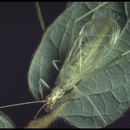pt-BR
nomes no trilho de navegação


Identification: Length 15-18 mm. Black mark on first antennal segment round or oval; length of black mark on second antennal segment greater that half length of segment; width of dorsal field of male forewings more than 0.4 the length; more than 35 teeth in stridulatory file.
Habitat: Shrubbery and vines around houses, unsprayed fruit trees, tangles of vines and trees at edges of clearings and along neglected fence rows; broadleaved trees, esp. scrubby oaks.
Season: July to October; one generation per year.
Song at 25°C: Regular, melodious chirps at ca. 2.8 ch/sec. in the east and ca 3.1 ch/sec in the west. Chirps usually have either 8 or 5 pulses, produced at ca. 52/sec. A chirp's pulses are not quite evenly spaced—chirps generally begin with a group of two pulses closely followed by consecutive groups of three. Thus most chirps have pulses grouped as 2,3,3 or 2,3. Carrier frequency is 2.7 kHz.
Song data: See Fulton 1925 and Walker 1962. Similar species: Riley's tree cricket—dark mark on second antennal segment reduced (less than half length of segment) or absent; center of mark near distal border of segment.
Remarks: The snowy tree cricket is sometimes called the “thermometer cricket” because its chirps are easily countable and their rate correlates well with the temperature at the cricket. In eastern United States, Fahrenheit temperature can be estimated by counting the chirps in 13 sec. and adding 40. West of the Great Plains, the snowy tree cricket chirps a bit faster (at a given temperature) and the recipe changes—e.g., count the chirps in 12.5 sec and add 38. Of course if you are really interested in using the snowy tree cricket as a thermometer, you should calibrate your local crickets against a thermometer placed near where they sing. Count their chirps per minute at a variety of temperatures, graph the results, draw a line that fits the points, and use a little algebra to arrive at a handy formula. One explanation of why snowy tree crickets sing faster in the West is that their faster chirps are more easily distinguished from the similar but slower chirps of Riley's tree crickets, which do not occur in the East. Careful studies in the West of chirp rates in and out of the zone of overlap between snowy and Riley's tree crickets should help interpret the variation.
There is yet more to know about the song of the snowy tree cricket. Nathaniel Hawthorne described it as “audible stillness” and declared, “If moonlight could be heard, it would sound just like that.” On a more commercial note, producers of movies and television shows often dub the song of this species onto sound tracks to signal that the action is taking place on a quiet summer’s night in a rural or suburban setting.
More information: genus Oecanthus, subfamily Oecanthinae.
References: Shull 1907; Fulton 1915, 1925, 1926b; Allard 1930a, 1930b; Walker 1962, 1969; Block 1966.
"
"